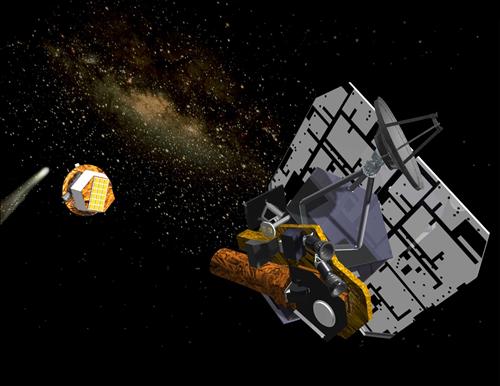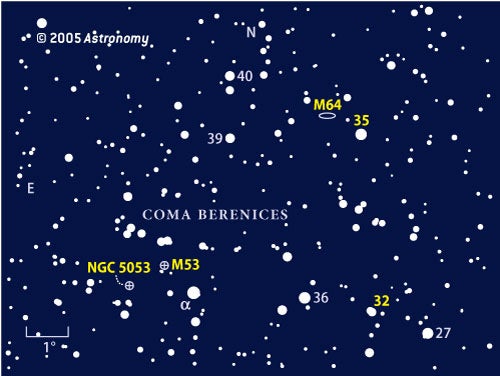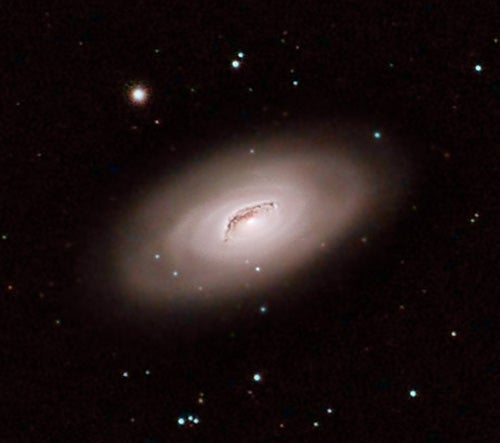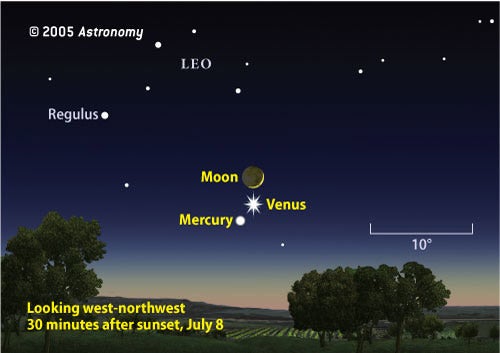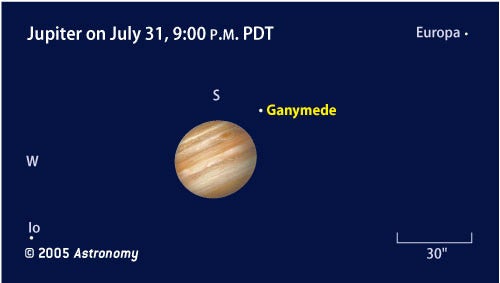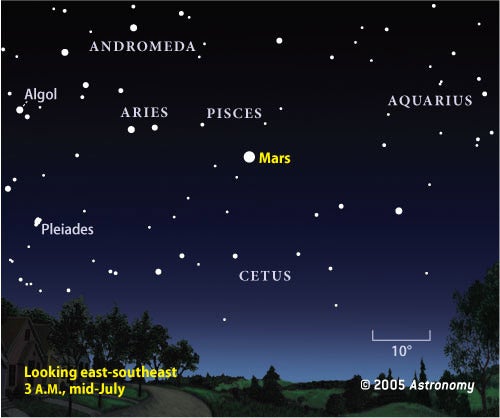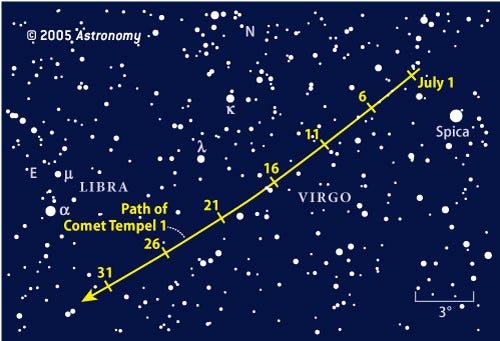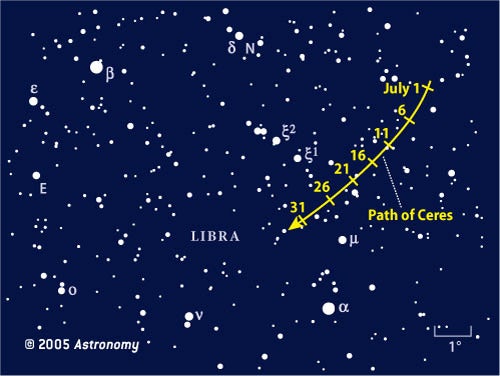A second periodic comet, 161P/Hartley-IRAS, glows low in the north. During their journeys across the sky, comets can draw our attention to interesting sights beyond our solar system. Don’t miss Hartley-IRAS at the end of June when it skirts the Double Cluster in Perseus, a spectacular grouping of hundreds of stars.
The solar system’s clockwork motion brings Saturn in line with the Sun this month, which prevents us from getting a good view. We’ll have to wait until the latter half of August for it to return to the sky before dawn. On the other hand, gas-giant Jupiter remains a fine sight after sunset in the southwest. Look for a bright, steady beacon about one-third of the way up the sky. The earlier in the evening you observe it, the better your chances to spot cloud features called barges and festoons.
Use your binoculars to follow the extended dance between Venus and Mercury. Lurking low in the west-northwest about 45 minutes after sunset, the two planets appear side-by-side July 1. Venus shines brighter, appearing somewhat yellowed by our atmosphere. Mercury shows as a fainter dot to Venus’ left. During the next 2 weeks, the innermost planet drops back toward the Sun gradually, fading from view after midmonth. A pale crescent Moon joins the pair the evening of July 8. A wide-field telescope at its lowest power will show the inner planets in the same field of view during July’s first week.
During the evening hours, many will assume the beacon in the west-northwest is an aircraft’s landing light. This brilliant planet inspired humanity to create the poetry and mythology of Venus long before written words graced a page.
From the Southern Hemisphere, Venus and Mercury make a spectacular sight in a darkened sky. The view’s much better from down south because the line from the Sun to the planets stands almost straight up compared with the shallow angle it makes for northerners.
Longer days and steeper rays of sunlight make this the summer season for the Northern Hemisphere. It surprises many people to learn Earth actually lies at its farthest point from the Sun July 4/5. The egg shape of Earth’s orbital ellipse is so slight, however, your eyes couldn’t tell the difference from a perfect circle without seeing one next to the other.
The Moon’s orbit around Earth deviates from a circle much more than Earth’s orbit around the Sun. When the Moon reaches its full phase July 21, it will be near its second-closest approach to Earth of 2005, bringing exceptionally high and low tides to coastal areas. Compare this Full Moon with images from last December or next February, and you’ll see how much bigger it appears now.
Combine this bigger Moon with the “Moon illusion” — our satellite’s tendency to loom larger when it lies near the horizon — and it will seem huge as it rises July 21. You can make it shrink by sighting the Moon through a cardboard tube. The Moon illusion is so complex entire books have been written on it.
Double up
Although the small constellation Coma Berenices doesn’t look like much to the naked eye, it packs a full complement of splendid deep-sky objects. Two months ago, we focused on the constellation’s northern end. This month, we tackle the Blackeye Galaxy, a pair of globular clusters, and some double stars on the southern side.
From July 13 to 15, asteroid Pallas shares a medium-power field with 32 Com. Pallas traces a path just north of the stellar pair. The asteroid glows at magnitude 9.5, less than one-tenth as bright as the stars.
Sweep 4° due north of 32 Com and you’ll land on a true binary star, 35 Com. This system’s stars orbit each other with a period of 510 years. Just 1″ separates the two, putting them near the limit for a 5-inch telescope under steady skies. You’ll need a magnification of at least 250x to split them. The 5th-magnitude primary lies north of the companion and outshines it by 2 magnitudes.
You can use 35 Com as a springboard into the depths
of space. The Blackeye Galaxy (M64) lies 0.9° east-northeast of the binary system. German astronomer Johann Bode discovered the object in 1779, beating his contemporary, Charles Messier, to the punch. Glowing at 9th magnitude with a size of 13′, the galaxy appears as a reasonably bright oval surrounding a pinpoint core. It gets its nickname from a huge swath of obscuring dust on its northern side. If you’re new to observing, the dark patch may not be visible right away. With practice, the patch shows up through a 6-inch scope.
Granular globulars
Some of the universe’s oldest objects are globular clusters — dense stellar spheres typically containing several hundred thousand stars. We see more this time of year because they orbit the Milky Way’s center, which lies in the summer constellation Sagittarius. It’s a perspective effect that comes from our vantage in the “galactic suburbs.” Coma Berenices provides a rare treat by having two globulars in one low-power field so far from “downtown.”
One degree northeast of Alpha Com lies M53. Although it, too, was first seen by Bode, Messier’s catalog has stood the test of time. This 7.5-magnitude globular appears as a fuzzy “star” through binoculars, and shows up nicely in a small scope. If the air is steady, crank the power past 200x and look for individual stars. The brightest glow at 14th magnitude, so you’ll need a 6-inch scope to detect the glimmers. M53 lies 58,000 light-years from Earth.
Just 1° southeast of M53 is the second cluster, NGC 5053. Although it lies some 5,000 light-years closer to us, it appears smaller and fainter. If you can resolve M53 into individual stars, then NGC 5053 will sparkle subtly as well.
Mercury and Venus remain neighbors in the gathering twilight during the first 2 weeks of July, although they aren’t as close as they were in late June. Venus gleams nearly 40 times brighter and will be a cinch to see in bright twilight. Mercury has started to fade and will require more patience to locate.
Venus sits in front of the cluster’s center July 3, but again twilight will interfere. On July 22, Venus stands 1° above 1st-magnitude Regulus, Leo the Lion’s brightest star.
You might glimpse Saturn July 1, before it succumbs to twilight. The planet sets 1 hour after the Sun, and falls from view after July’s first week. Saturn lies behind the Sun as seen from Earth at solar conjunction July 23. In late August, the planet reappears before dawn.
Brilliant Jupiter dominates the southwestern evening sky. The giant planet shines at magnitude –1.9 in mid-July, making it the brightest point of light in the sky after Venus sets. Through a telescope, Jupiter appears 35″ across its equator but only 33″ from pole to pole. The difference gives the planet a squashed appearance. The most obvious features on Jupiter are two dark cloud belts running parallel to the equator.
As July opens, Jupiter stands 1.5° below Gamma (γ) Virginis, Virgo’s second-brightest star. During the next 2 months, watch every clear night as Jupiter sinks toward the horizon and Venus rises to meet it. Their motion sets the stage for a conjunction of the two brightest planets in early September.
This month, Jupiter reaches a positional milestone: An imaginary line from the Sun to Earth to Jupiter forms a right angle. This configuration is called quadrature, and Jupiter reaches it July 1.
Why should this interest us? The geometry means that from our vantage point, Jupiter’s shadow extends as far east of the planet as possible. So, as the Galilean moons orbit Jupiter, we see them enter or leave the shadow farther from the planet’s limb than at other times.
Here’s how a typical sequence plays out for Ganymede: As Ganymede heads behind Jupiter, the planet’s western limb blocks the moon from view. A few hours later, Ganymede reappears at Jupiter’s eastern limb. A couple of hours after that, Ganymede disappears as it enters Jupiter’s shadow. Ganymede takes another few hours to traverse the shadow, then returns to full brightness as the eclipse ends.
Part of this sequence can be viewed the evening of July 31. Ganymede reappears from behind Jupiter’s limb at 10:37 p.m. EDT and enters Jupiter’s shadow 124 minutes later. Eastern North America gets the best view of the first event, while the West Coast sees the second event (at 9:41 p.m. PDT). Callisto can exhibit similar sequences, although not at this point in Jupiter’s orbital year. Io and Europa lie too close to Jupiter for either occultation reappearance or eclipse disappearance to be seen.
After Jupiter sets, three distant planets take center stage. Uranus, Neptune, and Pluto present challenges for a variety of equipment. First up is Pluto, the hardest to see, followed by Neptune, and finally Uranus, an easy binocular target.
Following the challenge of detecting Pluto, finding Neptune will be a breeze. Glowing at magnitude 7.8 among the stars of Capricornus, Neptune can be glimpsed through binoculars, and a telescope makes the task easy. The planet lies midway between Iota (ι) and 29 Capricorni in early July. Neptune’s motion carries it westward until it lies 0.9° due south of 29 Cap at month’s end. Neptune will reach opposition early next month, when it will be closest to Earth for the year, 2.7 billion miles away. Through a telescope this month, Neptune appears 2.3″ across and sports a blue-gray hue.
Lying about 930 million miles closer to us than Neptune, Uranus appears brighter and bigger. At magnitude 5.8, Uranus glows bright enough to see with the naked eye from a dark site and is within easy range of binoculars. Its blue-green disk spans 3.6″, nearly 60-percent larger than Neptune’s. It shows up easily through a small telescope at moderate magnification. To find Uranus, first locate the 3.7-magnitude star Lambda (λ) Aquarii and place it about one-third of the way from the center toward the left edge of your binoculars’ field of view. Uranus will be the brightest object near the center of the field. When July opens, only 1° (two Moon-widths) separates the star and planet, a distance that nearly doubles by the end of the month.
The final planet to appear rises in the east around midnight, just as Jupiter prepares to set in the west. Mars shines at magnitude –0.2 in mid-July, making it the brightest point of light in the morning sky. The best views come when it appears highest in the sky just before dawn.
On July 17, Mars makes its closest approach to the Sun, called perihelion. It then lies 128.4 million miles from our star and 84.5 million miles from Earth. This distance makes the Red Planet appear 10″ across, a size large enough for small-scope owners to discern a reasonable number of features.
Mars also is approaching its winter solstice, which occurs in August. Like on Earth, Mars’ northern hemisphere experiences winter near perihelion.
This observing season, Mars’ south polar region tilts toward Earth, so observers can watch the south polar ice cap diminish. It’s the larger of Mars’ two polar caps and takes a long time to succumb to the Sun’s warmth. Later in the season, as the ice cap thins, small scopes may show major rifts in the cap.
Through a telescope, Mars shows a noticeable gibbous disk. The planet appears 84-percent lit in July, its minimum phase for 2005. By November, when Mars reaches opposition, we’ll see a fully illuminated face. Mars’ size and phase will grow significantly during the next few months.
The best-known annual meteor shower, the Perseids, begins in mid-July. That’s when Earth’s orbit carries us into the fringe of the debris stream left by Comet 109P/Swift-Tuttle during its many orbits around the Sun. Activity begins slowly, with peak action reserved for August.
Another shower active this month is the Delta Aquarids. This shower has two main radiants, and the southern one peaks the night of July 27/28. Typical rates fall below 20 meteors per hour. Observers at more southerly latitudes get the better view because they see the host constellation Aquarius higher in the sky. Delta Aquarid meteors tend to be faint, and a Last Quarter Moon will adversely affect the view this year.
An even less productive shower, the Alpha Capricornids, produces only about 1 to 4 meteors per hour. The shower peaks July 30, but is active for most of July and the first half of August. Even better: The Moon appears as a waning crescent around the predicted maximum, so it won’t interfere much with observations. Shower members have a distinctive slow speed and occasionally produce a bright fireball.
Near the Moon’s southwestern limb, a large flooded plain called Schickard dominates the scene. The crater’s floor appears dark except for a lighter region stretching from the southwestern to northeastern wall and a bright triangular area near the center. The Sun rises over the crater shortly before Full Moon, and the subtle shadings become more prominent under stronger lighting.
Look for the cluster of a dozen craterlets at the floor’s northern end. Also note the many craters superimposed on Schickard’s wall, best seen when partially filled with shadow shortly after the Sun rises over the crater. The crater measures 141 miles across and appears elongated because of the foreshortening effect near the lunar limb. The low walls emphasize the massive flooding by lava that occurred early in the Moon’s history, which stopped shortly before obliterating the crater walls.
On the night of July 17/18, the Moon blocks Antares (Scorpius’ brightest star) from view for observers in the western and southern United States. Regions to the north will see the Moon glide below the bright orange-red star. Along a narrow track stretching from the Northwest across the country to Florida, people will witness a grazing occultation. During these exciting events, observers can watch Antares disappear and reappear multiple times as it peeks out from behind the mountainous regions along the Moon’s limb. For occultation times for representative cities, see the table below.
| Antares occultation — July 17/18 | ||
|---|---|---|
| City | Disappearance | Reappearance |
| Houston | 11:22p.m. CDT | 11:54 p.m.CDT |
| Los Angeles | 8:14 p.m. PDT | 9:09 p.m. PDT |
| Miami | 12:46 a.m. EDT | 1:43 a.m. EDT |
| New Orleans | 11:35 p.m. CDT | 12:06 a.m. CDT |
| Phoenix | 8:32 p.m. MST | 9:16 p.m. MST |
| San Diego | 8:15 p.m. PDT | 9:12 p.m. PDT |
In the wee hours of July 4, Comet 9P/Tempel 1 gets slammed by an 816-pound projectile as part of NASA’s Deep Impact mission. Scientists hope to learn more about Tempel 1’s interior and, by extension, all such primordial balls of dirty ice. The collision could create an expanding cloud of dust and perhaps a new jet. If you observe from a dark location and have a little luck, you’ll see a fresh spray of material. Use the finder chart to zero in on the comet. See “Fireworks on the Fourth” in the June issue for more details on this unique event.
Mark your calendar for the night of June 29/30, when the comet sails past the delightful Double Cluster in Perseus low in the north. The best views come during late evening hours before the Moon rises and spreads unwanted light across the sky. Observing conditions improve during the next few nights as the Moon wanes and rises later. Wide-field images of this region will reveal many other open star clusters and several large emission nebulae. The yellow-white glow from Hartley-IRAS will make an interesting addition.
By the end of July, when the Moon has left the evening sky again, the comet will lie about halfway between Polaris and the Big Dipper.
If you stay up all night during the New Moon weekend of July 1 and 2, have a predawn peek at Comet 21P/Giacobini-Zinner. You’ll find the 10th-magnitude comet just west of the Pleiades star cluster (M45). Some returns of Giacobini-Zinner produce outbursts of the Draconid meteor shower in October. This time, scientists predict only a small increase above normal hourly rates.
The tried-and-true method is to detect its motion from one night to the next. Find Ceres’ approximate location and make a quick sketch of the star field. Don’t rely on a verbal description — it’s too easy to mess up. Simply come back a night or two later and compare the field with your sketch to see which dot moved. That is Ceres.

